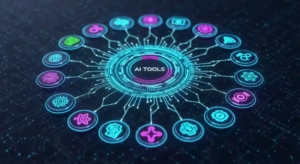AI and the Gig Economy: Automation Meets Freelancing

The blog post AI and the Gig Economy: Automation Meets Freelancing explores the intersection of artificial intelligence and the gig economy, emphasizing its transformative impact on freelance work. It begins by defining the AI gig economy and how automation reshapes job opportunities for freelancers. The article delves into various AI freelancing tools, highlighting their functionalities and benefits for individuals looking to enhance productivity and efficiency. Additionally, it compares different gig platforms that integrate AI, discussing notable variations in features and user experiences. Lastly, the post provides actionable steps for freelancers to thrive in this evolving landscape, emphasizing the importance of adaptability and skill enhancement to leverage AI successfully. By understanding the dynamics of the AI gig economy, freelancers can better prepare for a future increasingly influenced by automation.
Understanding The AI Gig Economy And Its Impact

The rise of the AI gig economy is transforming the traditional landscape of freelance work, driven largely by advancements in technology and automation. This paradigm shift offers numerous opportunities for remote work AI applications, enabling freelancers to leverage AI tools to increase efficiency and productivity. As automation tools become more integrated into the workflow of gig workers, they not only help streamline repetitive tasks but also allow for greater focus on creative and strategic elements of projects. Consequently, the symbiotic relationship between AI technologies and the gig economy fosters an environment where freelancers can thrive amid rapid changes in employment dynamics.
Key Features Of The AI Gig Economy
- Increased accessibility to freelance positions across various industries
- Enhanced productivity through automation of routine tasks
- Greater flexibility in work schedules, promoting work-life balance
- Networking opportunities with other global freelancers leveraging AI
- Real-time project management and collaboration tools powered by AI
- Potential for higher income due to specialized AI skills
- Continuous learning avenues through the integration of AI technologies
As freelancers adapt to the growing presence of AI in the gig economy, many are discovering that these tools can aid in skill development and personal growth. Embracing remote work AI solutions empowers freelancers to stay competitive in a rapidly evolving market. Those who can harness the potential of these technologies will not only optimize their existing workflows but also open the door to new business opportunities that utilize AI capabilities to surpass traditional practices in their fields.
Diving Deeper Into AI Freelancing Tools And Their Uses

In today’s fast-paced digital landscape, AI freelancing tools are reshaping the way freelancers operate, offering innovative solutions that enhance productivity and efficiency. These tools harness the power of artificial intelligence, enabling professionals to automate routine tasks, thereby allowing them to focus on more strategic and creative aspects of their work. The integration of automation is especially vital in the gig economy, where competition is fierce and time is of the essence. By leveraging AI, freelancers can optimize their workflows, allowing them to take on more projects and increase their income potential.
One of the primary benefits of utilizing AI freelancing tools is the reduction of mundane tasks, which can often consume valuable time. As automation becomes more prevalent in various sectors, it also opens up a new realm of possibilities for jobs that were previously unattainable. Freelancers can now engage in high-level projects that require critical thinking and creativity, which can be complemented by AI-driven insights and analytics. This shift not only enhances job satisfaction but also pushes the boundaries of what freelancers can achieve within the gig economy.
| AI Freelancing Tool | Primary Function | Benefits |
|---|---|---|
| Upwork | Project Management | Streamlined communication and tracking |
| Canva | Graphic Design | Automated design suggestions and templates |
| Grammarly | Writing Assistance | Enhanced grammar and style recommendations |
| Zapier | Workflow Automation | Integrates multiple apps for seamless tasks |
To maximize the potential of these tools, freelancers should adopt best practices that integrate AI seamlessly into their work routine. This includes regularly updating tools to ensure they are utilizing the latest features and benefits. Moreover, freelancers should actively seek out training resources or webinars to enhance their understanding of how to effectively implement AI solutions in their processes. By doing so, they can not only increase their productivity but also stand out in a crowded market.
Top AI Freelancing Tools
- Upwork
- Canva
- Grammarly
- Zapier
- Otter.ai
- Hubstaff
- Adobe Spark
Features Of AI Freelancing Tools
One of the most notable features of AI freelancing tools is their ability to analyze data and provide insights that can inform decision-making. These features automate repetitive tasks and generate suggestions based on user behavior, thus enhancing the overall user experience. Additionally, many tools offer collaborative features that make it easy for freelancers to work with clients and teams across different time zones, creating a more dynamic and responsive working environment.
Best Practices For Using These Tools
To harness the full potential of AI freelancing tools, freelancers should prioritize integration within their existing workflows. Regularly reviewing the performance of these tools and adapting their usage based on project needs is critical. Setting aside time to explore new functionalities can also lead to improved outcomes. Ultimately, embracing the possibilities offered by automation not only aids in better job management but also fosters growth in the ever-evolving landscape of the gig economy.
Comparing Gig Platforms AI Integration: Key Differences
The landscape of the AI gig economy is continually evolving, with various platforms incorporating artificial intelligence to enhance their services. Each platform has its own approaches to AI integration, aiming to streamline processes for both freelancers and clients. Understanding these differences is essential to navigate the options available and to select a platform that aligns with your specific needs. This section delves into the key distinguishing features of popular gig platforms, focusing on how their AI capabilities influence user experience and productivity.
| Gig Platform | AI Features | Target Audience |
|---|---|---|
| Upwork | AI-driven matching algorithms | Freelancers and Businesses |
| Fiverr | AI chatbots for client communication | Freelancers across diverse fields |
| Freelancer.com | AI analysis for project bids | Global freelancers and clients |
| Guru | AI tools for performance tracking | Professional freelancers |
As we explore the AI gig economy, it becomes evident that the integration of AI varies significantly among platforms. The primary purpose of these AI enhancements is to facilitate better matches between freelancers and clients, thus increasing efficiency and satisfaction. However, the level of sophistication and the specific functionalities offered can greatly differ from one platform to another, affecting how freelancers market themselves and secure work.
Overview Of Popular Gig Platforms
Different gig platforms cater to varying audiences, each providing unique AI functionalities. For instance, Upwork utilizes complex algorithms to analyze freelancers’ profiles and match them with suitable job postings. On the other hand, Fiverr employs AI chatbots that assist in immediate client interactions, ensuring potential clients receive prompt responses, which can enhance conversion rates. By understanding these functionalities, freelancers can better leverage their skill sets on the right platforms.
Pros And Cons Of Different Gig Platforms
- Upwork: High-quality projects but competitive bidding process.
- Fiverr: Quick access to projects; however, potentially lower pay rates.
- Freelancer.com: Large global audience but can be overwhelming due to numerous listings.
- Guru: Strong performance tracking tools, yet may have fewer opportunities compared to others.
- PeoplePerHour: Focus on hourly jobs, but limited to certain professions.
In conclusion, the differences in gig platforms AI integration can significantly impact a freelancer’s experience and success in the gig economy. By familiarizing themselves with these platforms and their respective features, freelancers can strategically position themselves to thrive in an AI-driven market.
Actionable Steps To Thrive In The AI-Driven Gig Economy

As the AI gig economy continues to evolve, adapting to this transformation is essential for freelancers seeking sustainable opportunities. Automation plays a significant role in reshaping the nature of jobs, making it crucial for gig workers to leverage these advancements effectively. By integrating automation into their workflows, freelancers can enhance productivity and improve their service offerings, positioning themselves as indispensable assets in an increasingly competitive market.
Essential Steps For Success
- Embrace AI Tools: Utilize AI-powered applications to streamline your workflow and enhance your skills.
- Focus on Niche Markets: Identify and specialize in specific areas where human creativity still reigns supreme, complementing automated processes.
- Enhance Your Skill Set: Regularly upskill to stay relevant; consider learning about automation technologies that pertain to your work.
- Network with Other Freelancers: Connect with peers to exchange insights and strategies about navigating the AI gig economy effectively.
- Stay Informed: Keep abreast of industry trends and changes in AI applications that could influence the jobs landscape.
- Market Yourself: Invest time in building a strong online presence and showcase how you utilize automation as a value-add.
Implementing these essential steps will empower freelancers to thrive despite the rapid changes brought about by technological advancements. By understanding the dynamics of the AI gig economy, including how automation affects various jobs, freelancers can maintain their relevance and competitiveness. Preparing for the future means being proactive and adaptively integrating automation into your workstyle, ensuring you not only survive but thrive in this transformative landscape.
For similar articles, please visit: AI and the Future of Work
Homepage / humanaifuture.com




